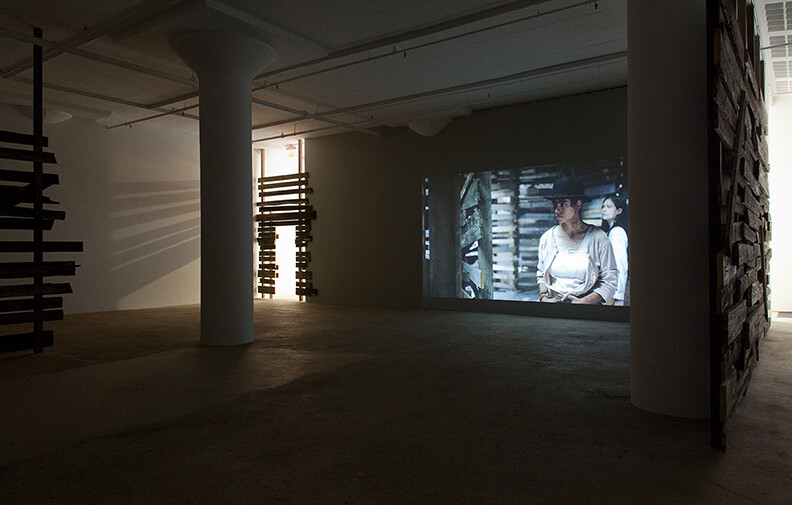“Nothing is true, everything is permitted.” A fine phrase for art, but just as eerily appropriate for politics in these days of technocratic, neoliberal control over “non-societies” jam-packed with contemporary “me only” pathologies—from entrepreneurship bullshit to non-dom tax evasion. What William Burroughs couldn’t possibly have imagined was how this iconic sentence from his Red Night Trilogy (1981–1987) would, in time, mirror another phrase, instated by Britain’s Iron Lady: “There is no alternative!”
Despite its close relationship with Burroughs’s work, in Joachim Koester’s solo show at Greene Naftali not everything is permitted. In the main room, anonymous bodies communicate, exasperatingly, in a language whose bodily grammar is found somewhere between hallucinogenic and repressed oblivion—all in a set of four moving image works. At its heart screens The Place of Dead Roads (2013), Koester’s video adaptation of Burroughs’s 1983 Wild West novel, which tells the time-traveling tale of gay gunslinger cowboy Kim Carsons, shot dead in 1899, who desires only to escape his body-prison out into the immortal cosmos. But Carsons is nowhere to be seen, either in the video or in the show. More important to the exhibition’s spirit is the series Some Boarded Up Houses (2009–2013) that greets us in the form of a long row of black-and-white photographs of derelict buildings across the US, post-2008 sub-prime mortgage crisis. Despite their anesthetized conceptual framing, the photos nonetheless feel ghostly and inhuman, as if the spirits of these family houses had not yet quite departed. In other words, families evicted out into the streets of a country deeply suspicious of those who claim its welfare, and which has cut mental health services by almost 5 billion dollars since 2009, turning the sick into urban scavengers. The place of dead roads leads to the bodies of the crisis, and vice-versa to the crisis of bodies.
Koester has a penchant for imaginative (though not imaginary) spaces—historically recognizable as forgotten, suspect, illogical, nonsensical, in a word, un-modern. Stripped of narrative, in the 30-minute video The Place of Dead Roads (2013), cowboy-clad Indians (and one or two predictable Caucasians) sweat out bandit tropes such as the fastest—in Koester’s case, the jitteriest—draw of guns in the West, looking for a target, for anyone to shoot down. There’s not a single bullet shot, however. Abandoned and left to themselves, these cowboys are simply aching, debt-ridden bodies, I suspect, constantly in spasms, like shot-down meat. They can only dance with one another, as if in an animal courtship ritual of unconsummated sex in the Wild West, and again spiriting financial America—the place of dead roads indeed for many Amerindian pueblos, and the secret of my enchantment with Koester’s mute video.
Koester’s long-standing obsession for séances—the subtitles on 16mm celluloid from Of Spirits and Empty Spaces (2012) and the close-ups of a 16mm projector in Body Electric (2014) screen in their own, dedicated darkened room—invokes the lost freedom and communalism, as anthropology attests to it, of Amerindians, who should answer neither by Amer[ican] nor Indian, but by their proper names:
Inuit, Malecite, Naskapi, Montagnais, Beothuk, Micmac, Abenaki, Pennacook, Passamaquoddy, Iroquois, Mahican, Algonquian, Huron, Ottawa, Mohawk, Oneida, Onondaga, Cayuga, Seneca, Cree, Narragansett, Pequot, Potawatomi, Susquehannock, Delaware, Powhatan, Tuscarora, Tutelo, Cherokee, Chickasaw, Creek, Choctaw, Biloxi, Natchez, Caddo, Atakapa, Calusa, Apalachee, Tonkawa, Wichita, Osage, Kaw, Niúachi, Lucayan, Seminole, Comanche, Kiowa, Arikara, Mandan, Karankawa, Arapaho, Shawnee, Illinois, Sauk, Erie, Kickapoo, Winnebago, Meskwaki, Menominee, Pawnee, Sioux, Ojibwa, Cheyenne, Ponca, Omaha, Crow, Assiniboine, Okanagan, Kutenai, Blackfeet, Chipewyan, Dogrib, Dene, Kootenai, Nez Perce, Paiute, Shoshone, Bannock, Ute, Navajo, Hopi, Apache, Pima, Seri, Opata, Chumash, Serrano, Cochimi, Cahuilla, Tarahumara, Papago, Yaqui, Yokut, Miwok, Hupa, Maidu, Pomo, Nootka, Chinook, Salish, Tsimshian, Haida, Tlingit, Aleut.
In a previous work, To navigate, in a genuine way, in the unknown necessitates an attitude of daring, but not one of recklessness (movements generated from the Magical Passes of Carlos Castaneda) (2009), not shown here, Koester silently resurrected the American anthropologist-cum-fiction writer Carlos Castaneda, famous for supposedly faking his shamanistic teachings with a Yaqui called Don Juan Matus in the late 1960s—a veritable “Nothing is true, everything is permitted” iteration. In that 16mm film, the body is hallucinogenically liberated, aware, and finally electrified—regardless of whether they’re true, Castaneda’s shamanic stories deeply inspired a whole generation of hippie baby-boomers. Here, in contrast, divested of Burroughs’s non-normative omni-sexuality, Koester’s The Place of Dead Roads screens like a macabre, repressed, mass Indian extinction attempting to liberate itself through the body of frustrated puppet-like killers. A human extinction that, in a time when the financial elite has detached itself fully from the mass of the people, is now catching up on the middle-class, who, in great shock, are finally realizing they too are the destitute and dispossessed.
Purposely or not, the subject of Koester’s work here is embodied economics, so that in the 16mm, black-and-white film Variations of Incomplete Open Cubes (2011), the body becomes simply the source of failed solutions for the trauma of quantification, hands searching for some sort of rationale or organic golden rule energetically looping in failure. If the economy often looks like magic, then crises feel like sorcery. Capitalist sorcery. Caught in this crisis without end, we are left with not much else than our bodies, but are bodies enough to break the spell?










